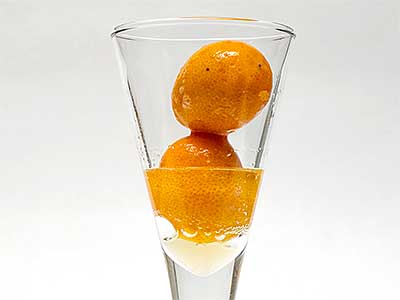November 12, 2012
Intermède

kumquat gazéifiée
(carbonated kumquats)
It’s been about two years since I bought my ISI Gourmet Whip Plus, or whatever fancy name it had when I bought it. It’s a type of siphon bottle similar to a seltzer bottle. If you frequented soda fountains 50 years ago, it’s the type of container that whipped cream was spritzed out of for banana splits and ice cream sundaes. I bought the half-liter size so I wouldn’t have to fill it as full. For the first year it just sat on the shelf.
I first encountered these particular devices back in 2000 when I was staging at l’Château de Amondans in France. The chef was hot on espumas, the foams developed by Ferran Adrià in Spain. I think he was serving all the example recipes that came with the instruction book for the device. The staff never cleaned the valves properly so the devices seldom worked as intended, and the foams often failed.
By the time I got my siphon bottle, espumas were out of fashion. Most of the current recipes I’ve found for the devices are foams that are easy to duplicate with other devices, like the whisk attachment on my stand mixer, so I haven’t gotten much use out of it.
When I took Dave Arnold’s Magic Potions: Hydrocolloids class at the French Culinary Institute in 2011, he did a number of demos with carbon dioxide gas. He had a fancy, homemade set-up that included 20-pound gas cylinder. The CO2 cartridges that are sold for my siphon bottle hold about 8 g (1⁄4 oz) of gas. I don’t remember if he successfully carbonated some fruit at the class, but I’ve heard him talk about the process a number of times since then on his radio program.
In October of the same year, I was served a carbonated grape at the first anniversary of a local restaurant that my wife and I frequent. The carbonation was barely noticeable in the grape. Also, the grapes had been cut in half rather than peeled so there was a bitter taste from the skins.
When I was thinking about “stuffed” foods for a paper that I presented at the Oxford Symposium on Food and Cooking last summer, I thought of carbon-dioxide gas-stuffed foods. For the paper, I purchased some large red grapes, peeled them, and stuffed them with gas. They were highly carbonated and produced a nice tingle on the tongue as they were eaten. Because of all the gas stuffed inside, the grapes also swelled a bit and had a bit of a furry appearance.
I also had some kumquats on hand, so I threw a few of those into the bottle at the same time as the grapes. Before doing so, I took a small needle and pricked the kumquat skins all over. My idea was to provide entrances for the gas to be introduced to the interior of the kumquat. Once the lid of the siphon bottle was in place, the bottle was charged with two cartridges of carbon dioxide. I shook it right away, and placed it in the refrigerator for a couple of hours. Just before serving, I shook the bottle again, and released all the gas as quickly as I could. I served two kumquats per portion with a few drops of a sweet, white wine drizzled over the top.
I had two thoughts as I ate the gasified kumquats: it would be nice to find a way to remove the seeds without damaging the skin, and this would be great with lychees.
© 2012 Peter Hertzmann. All rights reserved.
